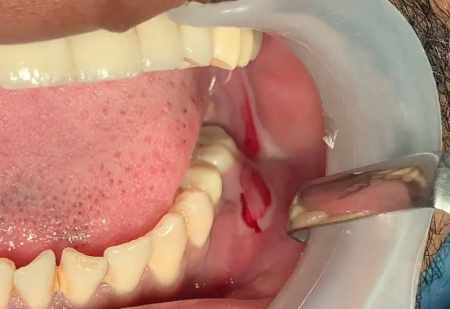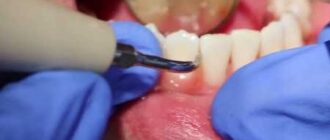Pus can build up in the gum because a periodontal abscess has developed there. There will be pus and bleeding from the tooth next to where the abscess occurred. In addition, the tooth will be sore and aching. Pus can be caused by periodontal disease, its development, or tooth decay that was not treated in time.
Causes of Pus
If you have a purulent discharge from the gum, there is a pimple, inside which pus accumulates, pain is felt, teeth are aching, then you should not delay, but immediately go to the doctor. If you run a purulent inflammation that has formed in the gum, there can be serious consequences. It can even go as far as blood poisoning.
As for the purulent pimple, it can be any size. For some, it can resemble the shape of a pea, and sometimes it can reach the size of half a walnut. But you should know that you can not judge the seriousness of the problem by the size of the pimple. If there is a purulent pimple and it is small, if not treated, it can significantly increase in a day.
Festering can occur for the following reasons:
- The gum has been traumatized by a shard of tooth that was broken. The gum may also be scratched by a poor quality crown that will overhang the edge of the gum;
- the hygiene routine was performed with a very hard toothbrush;
- the person has been careless with a toothpick in the teeth.
It should be known and understood that every manipulation that has to do with the teeth should be done carefully and cautiously so as not to touch the gum. In the case of pus, the person must realize that there is already an inflammatory process. And it must be treated without delay.
What to Do?
The most important thing is never to warm the place that hurts. Once grandmothers said that it was necessary to bandage the cheek with a warm handkerchief, but you should not do this. Inflammation should never be heated. If the temperature rises, the process becomes even worse. If there is pus, you should put a piece of ice on the place that hurts.
If the pus came out of the gum, you should not think that everything is gone. Medicinal treatment is necessary to stop the process. But antibiotics should be prescribed by a doctor.
How the Disease Develops
Initially, a person does not suffer from the fact that a small festering has formed. Pain may occur when he eats, may bleed when he brushes his teeth or emit pus if you put pressure on the root of the tooth. Later, more pus becomes in the gum, which causes the infection to spread. If the necessary treatment is not given, healthy teeth may begin to fall out.
When the disease first starts, pus accumulates in one tooth, but after a while, it can go to other teeth and take the form of chronic periodontal disease. Therefore, as soon as you see the abscess, go to a specialist and consult with him.
Treatment and Prevention of Pus in Gums
How do I treat gum disease? There are many ways to treat gum inflammation at home. Dentists usually recommend an antiseptic, anti-inflammatory medicine. The optimal treatment regimen is prescribed by the dentist after diagnosis. Consider the most effective therapeutic options.
What to rinse my mouth with to get rid of pus?
Gargling with special solutions helps to quickly get rid of pain and stop the inflammatory processes occurring in the soft tissues. Solution formulations disinfect the surface of the gum, destroying pathogenic bacteria. It is necessary to rinse the gums after each meal, from 2 to 4 times a day. Some products in this group are used in their pure form, while others need to be diluted in water.
To solve the treatment of inflamed gums, dentists usually prescribe the following solutions:
- Furacilin;
- Chlorhexidine;
- Miramistine;
- Rotocan;
- Stomatofit ;
- Malavit;
- Listerine.
The listed remedies are usually used to prevent oral diseases, reduce soreness and reduce inflammation, but do not belong to the independent means of treatment. Therefore, gargling is usually prescribed in conjunction with other treatments.
Brushing and rinsing with an irrigator with special solutions
Treatment of gum inflammation at home is possible with the help of an irrigator – a modern device for oral care, surpassing the effectiveness of a toothbrush. The principle of operation is based on the directional jet of water, which helps to clean even hard-to-reach places.
When inflamed gums irrigator becomes indispensable: unlike a toothbrush it does not hurt the gums, the pressure of the jet can be adjusted, and most importantly – the device can be placed medication solutions and rinses.
The following solutions are suitable for use in an irrigator:
- Donfeel. Available in two types: for daily use and for the treatment of teeth. The composition includes only natural ingredients and vitamin complex, extracts of medicinal plants such as mint, chamomile, calendula, lemon balm. Because of this, the solution has a soothing effect, suitable for children and adults.
- Peridex. A professional care product that includes 0.2% chlorhexidine. Widely used for therapeutic purposes, it effectively destroys pathogenic bacteria.
- PerioGard. Chlorhexidine-based antiseptic, eliminates dental plaque, prevents the development of gingivitis.
- Asepta. A multipurpose solution used to remove bacterial plaque and has a wound-healing effect.
The advantages of using the irrigator in the treatment of gums include a gentle effect on the inflamed tissues and absolute painlessness.
Therapeutic ointments and gels
To treat pain in the gums at home, you can remedies of local action: ointments and gels with an antiseptic effect. They enhance the effect of rinses, complement other types of treatment. Such means include:
- Metrogil Denta – an antimicrobial drug created on the basis of two antibacterial components: chlorhexidine and metronidazole;
- Parodontocyte – contains extracts of medicinal plants: mint, sage, clove and oregano;
- Gengigel – contains hyaluronic acid, promotes tissue regeneration;
- Stomatofit A – gives an analgesic effect, is used for long-term therapeutic action;
- Holisal – is used for local anesthesia, has an antimicrobial effect;
- Asepta – propolis-based balm with wound-healing effect, helps fight bleeding;
- Solcoseryl – a strong anesthetic, promotes rapid recovery of the mucosa;
- Revive – restores calcium levels, makes tooth enamel stronger.
All ointments and gels form a protective film on the surface of mucous membranes, which gives a long-lasting effect.
Toothpastes
With inflamed gums you should use special toothpastes. These are drugstore remedies based on extracts of herbs and medicinal plants. Such pastes are used strictly by prescription, applied to the teeth and gums. Treatment is performed by courses of no more than 1 month each, after which a break is made.
Antibiotics
Appointed in complicated and neglected cases, when other treatments do not work. Antibiotics are prescribed by the attending physician, based on the etymology of the disease. It is forbidden to take the drugs of this group on your own. Self-treatment can worsen the condition of the patient, often causing side effects.
The maximum effect of antibiotic treatment of the gums can only be achieved in combination, combining medications with irrigators, gels and rinses.
Vitamins
Vitamin complexes – an auxiliary therapeutic technique that complements other treatments. They make up for the lack of useful enzymes needed to strengthen the tooth enamel and soft tissues. For inflammation and bleeding gums, vitamins of groups are usually prescribed: A, B, C, K, E, RR.






